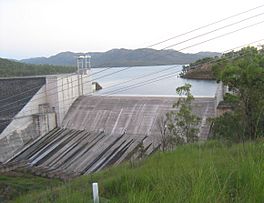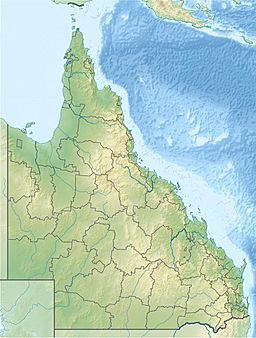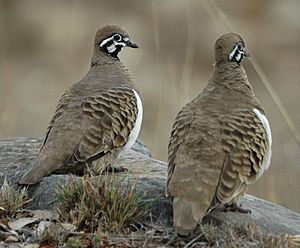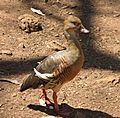Lake Awoonga facts for kids
Quick facts for kids Lake Awoonga |
|
|---|---|
 |
|
| Location | Via Benaraby, Central Queensland |
| Coordinates | 24°04′31″S 151°18′29″E / 24.0753°S 151.308°E |
| Type | reservoir |
| Primary inflows | Boyne River |
| Primary outflows | Boyne River |
| Basin countries | Australia |
| Surface area | 6,750 ha (16,700 acres) |
| Water volume | 777,000 ML (630,000 acre⋅ft) |
| Surface elevation | 40 m (130 ft) AHD |
Lake Awoonga is a large lake in Central Queensland, Australia. It was created by building a dam on the Boyne River. The lake is about 30 km (19 mi) from Gladstone, which is about a 30-minute drive away.
Lake Awoonga is super important because it provides the main water supply for the whole Gladstone area. It's also a fantastic place for fun activities like fishing and boating. The best part? The recreation areas and fishing spots are free for everyone to enjoy, thanks to the Gladstone Area Water Board!
Contents
Building Lake Awoonga
The Awoonga Dam was built across the Boyne River, southwest of Gladstone. It's a special type of dam made from lots of rock, with a smooth concrete front. The rock for the dam wall came from a quarry right next to it!
The dam wall is over 650 metres (2,130 feet) long and 54.4 metres (178 feet) high. That's like two football fields end-to-end! It holds about 2,000,000 cubic metres (71,000,000 cubic feet) of rock. The dam was finished in March 1985.
When Lake Awoonga is completely full, the water level is 40 metres (130 feet) (about 111 feet) above sea level. The dam was designed so it can be made even taller in the future if more water storage is needed.
Amazing Animals of Lake Awoonga
Lake Awoonga is home to many different animals, some of which are quite special. You might spot grey-headed flying foxes or yellow-bellied gliders here. The plants in the water provide food and shelter for fish, eels, turtles, and even platypuses!
Around the lake, you can find other native animals like bandicoots, rufous bettongs, kangaroos, wallabies, greater gliders, and brushtail possums.
Birds of the Lake
More than 225 types of birds live around Lake Awoonga! This includes the southern squatter pigeon, which is a vulnerable species. Many other birds here are protected by international agreements because they migrate long distances.
Fish and the Breeding Program
The Gladstone Area Water Board has a special program to breed fish. They raise barramundi and mangrove jack to release into Lake Awoonga and other nearby waterways. About 200,000 fish are released into Lake Awoonga every year!
These fish are raised at a special hatchery. It's one of the biggest places in Queensland for breeding barramundi babies. Lake Awoonga also has the most mangrove jack in Australia, with over 50,000 released!
Other fish you can find in the lake include eeltail catfish, eastern rainbowfish, sea mullet, and spangled perch. Since 1996, over 2.5 million barramundi and 470,000 mullet have been released. Fishermen often catch barramundi weighing between 10 and 25 kilograms here. The biggest barramundi ever caught in Lake Awoonga (as of November 2008) weighed an amazing 36.5 kilograms (80.5 pounds)!
Green Life Around the Lake
More than 415 different types of plants grow around Lake Awoonga. They are super important for keeping the lake healthy! You can find everything from thick vine areas and rainforests to tall woodlands.
Aquatic Plants
In the shallow parts of the lake, there are over 45 types of water plants, like ribbon weed and hornwort. These aquatic plants are very important. They provide food and shelter for animals, help stop the river bottom from washing away, and recycle nutrients in the water.
Special Plants
Some special plants that need protecting also grow here. These include Persoonia Amaliae and Eucalyptus melanoleuca, which are rare. Cycas Megacarpa and Grevillea venusta are considered vulnerable. You can also find common protected species like Banksia integrifolia and Xanthorrhoea latifolia.
Weed Control
Unfortunately, some unwanted plants, called "environmental weeds," have spread around the river system. These include parthenium, salvinia, and lantana. To keep the lake healthy, there's a plan to control these weeds every year.
The Gladstone Area Water Board also works to replant native trees and plants that were affected when the lake was created.
Fun Things to Do at Lake Awoonga
Lake Awoonga is a great place for outdoor fun! You can swim from the shore, and there's a boat ramp open 24 hours a day. This means you can go sailing, fishing, or water skiing whenever you like. You can even rent different types of boats, including houseboats, or go on a fishing cruise.
The rules for using the lake are managed by the Queensland Boating and Fisheries Patrol and Queensland Water Police. Everyone using the lake needs to follow the speed limits.
Fishing at the Lake
Lake Awoonga is a very popular spot for fishing, especially for barramundi. Even though there's a closed season for barramundi in other places, you can fish for them all year round at Lake Awoonga! Just remember that some limits still apply.
Camping and Picnics
If you want to stay longer, you can camp at two places: the Caravan Park and the Boynedale Bush Camp. The main recreation area is free for everyone. It has picnic shelters, barbecues, and walking paths.
The Boynedale Bush Camp is a simpler camping spot on the southern side of Lake Awoonga. It's about ten minutes from the small towns of Many Peaks and Ubobo. You get there by a dirt road, which might get muddy when it rains. There's no drinking water available at this camp, so bring your own!
Glengarry Homestead
When the dam was built, the water covered a lot of the land that belonged to Glengarry pastoral station. Because of this, the Gladstone Area Water Board bought the property in 1979. When the dam is at its highest, the historic Glengarry Homestead is expected to become an island in the middle of the lake!
Images for kids


















